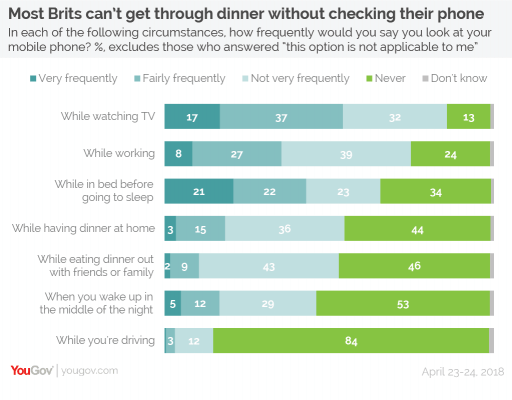The WaveWall Blog
Top 10 Risks of Smartphone Usage
Smartphones are ubiquitous. Billions of people own them and use them every day. In fact, billions of people probably don’t know how to be without their phones.
While phones are revolutionary, they aren’t without their risks. Any small risks of smartphone use are likely to be magnified by us using them virtually every waking hour of the day. On average, people spend over 3 hours on their phone daily, checking it a total of approximately 58 times.
As some may know, phones emit radiation. The radiation is non-ionising, meaning it doesn’t necessarily directly cause DNA damage like ionising radiation, including X-rays and gamma rays. However, a growing body of research clarifies the impact phones have on our health, from potentially causing cancer to destroying our sleep and social interactions.
Here are the top 10 risks of excessive smartphone usage.
Table of Contents
1: EMF Radiation
Electromagnetic field (EMF) radiation is the key to many health risks resulting from phone use.
EMF is an unseen by-product emitted by all electronics, including smartphones, when they’re switched on.
Cell phones operate within a frequency range of 450 to 2000 MHz, although most modern models fall within the 800 to 900 MHz range. With the advent of 5G, these frequencies will climb to an unprecedented 300 GHz, thus exposing us to a broader frequency spectrum. The energy consumption of a phone depends on what you’re using it for. Calls demand more power, for example.

Despite a smartphone’s size, its proximity to our bodies throughout the day makes it a primary source of EMF radiation exposure, surpassing nearby cell towers. A host of health issues are associated with prolonged exposure to EMF radiation, including but not restricted to:
- Persistent headaches and neurological symptoms
- Insomnia
- Fertility issues
- Developmental issues
- Hormonal imbalances
- Digestive disturbances
- Cancer
The WHO now officially recognises EMFs as potentially carcinogenic.
There is rising interest in EMF. Berkeley researcher Joel Moskowitz said, “Cellphones, cell towers and other wireless devices are regulated by most governments…Our government stopped funding research on the health effects of radiofrequency radiation in the 1990s.”
Since then, he describes that research has shown significant adverse health effects associated with phone usage, including cancer. Evidence shows that certain tumours, like glioblastoma, are rapidly increasing in prevalence. There must be a cause, and while it’s tough to delineate exactly what that is, phones are firmly in the picture.

Still sceptical? Look at this. More than 250 scientists, who have collectively published over 2,000 papers and letters in research journals, signed the International EMF Scientist Appeal, which calls for stronger health warnings and stricter exposure limits.
The scientific community has some form of consensus on the ‘health time bomb’ that is phone radiation. What’s more is that, while phones are regulated with specific absorption rate (SAR) limits, the limit is comprehensively too high. Harm occurs at lower levels.
2: Brain Development and Screen Time
While modern technology and smartphones have enriched our lives, there are concerns about their impact on brain development, particularly in children.
One study illustrated that cell phones influence brain activity. In this experiment, participants had a cell phone strapped to each ear while their brain activity was measured using a PET scanner.
When the phone was switched on, there was an increase in glucose metabolism, indicating heightened brain activity near the phone’s antenna. This result implies that cell phone radiation could induce neurochemical changes.
Given their ongoing brain development and thinner skulls, children are more susceptible to potential harm. A report published in JAMA Pediatrics found a link between increased screen time during childhood and delayed development in communication skills, problem-solving, and social interactions.
Prolonged screen time can also lead to the premature thinning of the cortex, which includes sensory and motor areas, meaning it processes information related to the senses and motor functions.
Additionally, children’s skulls are much thinner than adults, meaning radiation penetrates them much more effectively.
3: Impact on Social Interactions
In an era of global connectivity, we can communicate with people worldwide at the touch of a button. While this has many advantages, it’s also impacted our social interactions.
When we’re constantly checking our phones, we can become less present in our immediate environment. This phenomenon is often referred to as ‘phubbing’ (phone snubbing). It can negatively affect our personal relationships, with studies suggesting that it leads to lower levels of relationship satisfaction.

Research has also suggested that the mere presence of a smartphone, even if it’s not being used, can harm face-to-face conversations. Participants who had a conversation in the presence of a smartphone, even when not in use, reported feeling less connected to their conversation partner compared to those who had a conversation without a phone present.
Furthermore, excessive use of social media on smartphones can lead to feelings of social isolation. We probably all know what social media-induced FOMO feels like – users may feel excluded or inadequate when comparing their lives to the curated, highlight-reel lives of others on their feeds.
Ultimately, in a world where digital interaction is becoming the norm, maintaining genuine, face-to-face human interaction becomes increasingly important for our overall well-being.
4: Impact on Attention and Productivity
Our smartphones can be massive distractors, stealing our attention even when we’re not consciously using them. This constant tug on our attention can substantially affect our productivity and cognitive function.
Research shows that receiving just one notification can cause enough distraction to significantly impair our focus, leading to a decline in performance on tasks requiring constant attention.
A study in the Journal of Experimental Psychology: Human Perception and Performance found that participants made significantly more errors in a task after a brief interruption, like a notification.

Beyond immediate distractions, frequent smartphone use can lead to changes in our cognition.
A study in the journal PLOS ONE found that individuals who regularly use multiple devices simultaneously (known as media multitasking) perform worse on cognitive control tasks and have more socio-emotional difficulties. This is thought to occur because frequent task-switching makes it harder for the brain to filter out irrelevant information, decreasing the ability to focus on a single task.
Another factor is the addictive nature of many apps, designed to keep us engaged for as long as possible using techniques such as endless scrolling and push notifications.
This can further contribute to the amount of time we spend on our devices and, consequently, the potential for distraction.
5: Physical Pain
Extended smartphone use can cause a range of physical ailments, often due to repetitive strain and poor posture. The term ‘text neck’ was coined to represent the neck pain and possible spinal damage that can occur from constantly bending your neck to look at your smartphone.
‘Text neck’ can potentially lead to serious long-term health problems like cervical degeneration and spinal misalignment. Symptoms often include neck pain, shoulder tension, headaches, and reduced mobility in the neck.
Another smartphone-related condition is ‘text claw,’ which refers to the aches and pains experienced in our fingers, hands, and wrists from repetitive scrolling, typing, or gaming on smartphones. This strain may exacerbate existing conditions like carpal tunnel syndrome or tendonitis. Over time, these repetitive strain injuries can cause chronic pain and could even require medical intervention.
Furthermore, extended screen time can result in digital eye strain, often called Computer Vision Syndrome. Symptoms include dry and irritated eyes, blurred vision, eye fatigue, and increased sensitivity to light.
Prolonged exposure can even lead to nearsightedness. Regular breaks and exercises and medical treatments like eye drops or glasses specifically designed for screen use can help alleviate these symptoms. Still, the best prevention is to reduce screen time.
6: Impact of Blue Light
Our modern lifestyles are saturated with screens, from work computers to televisions and, most notably, our smartphones. All these screens emit blue light, which silently disrupts our biological processes when we’re exposed to it in the evening and night.
Blue light, with its short wavelengths and high energy, has its benefits. It can elevate mood, increase alertness, and even assist in memory and cognitive function. Most importantly, it significantly regulates our body’s natural sleep and wake cycle, or circadian rhythm.
However, the issue arises when we’re exposed to excessive blue light, particularly at times when it wouldn’t naturally occur. This is where our smartphones, which we often hold close to our eyes, affect us profoundly.
Possibly the most well-known impact of blue light is its effect on sleep. Suppressing the secretion of melatonin, our sleep hormone, disrupts our circadian rhythm. Even low levels of blue light exposure can have this effect.
Studies have revealed that a large percentage of people use their phones before bed. Some even sleep next to their phone. One comparative study showed that blue light suppresses melatonin for about twice as long as green light, illustrating its potency.
Moreover, excessive blue light can affect the retina, potentially damaging light-sensitive cells, leading to issues like macular degeneration and permanent vision loss.
To mitigate these effects, consider limiting screen time, especially before bed, to protect your eyes and maintain a healthy sleep cycle.
7: Mental Health
Smartphones have significantly impacted mental health. With these devices providing endless entertainment, social interaction, and information, their presence has fundamentally changed how we live and feel.
Smartphones provide easy access to social media platforms, often leading to a distorted sense of reality. Users constantly exposed to idealised representations of other people’s lives might feel inadequate or unsatisfied with their own lives.
The feedback loop created by posting content and waiting for likes or comments can create a dependency on external validation for self-esteem.
One study researching the social risks of smartphones argues that phones increase stress through people “feeling compelled to promptly respond to cell phone activity in order to maintain spontaneity and access with others.” Many studies have associated phones – and most important social media – with worsening mental health outcomes.
This is common knowledge now, but does it encourage us away from our phones? Probably not in most cases. That underlines the tremendous grasp our phones have on our lives.
Additionally, smartphone addiction is a growing issue recognised by mental health professionals. Much like other forms of addiction, the compulsive behaviour triggered by smartphone interactions stimulates the reward pathways in our brains.
Over time, this can lead to neglecting essential aspects of life such as work, education, and in-person social interactions.
8: Phones are Crawling With Microbes
Did you know that cell phones can harbour ten times more bacteria than most toilet seats?
That’s precisely what a study from Arizona University found.
Germs and bacteria are the culprits behind many common and serious illnesses. Your mobile phone, with an astounding 25,127 bacteria per square inch, is essentially a petri dish.

It comes into contact with countless surfaces – hands, countertops, car seats – collecting and redistributing germs with each touch. Furthermore, the warmth of our bodies and batteries provides the ideal conditions for bacteria to thrive.
A study by the University of Oregon identified over 7,000 different bacteria species on phones. The most prevalent were Streptococcus, Staphylococcus, and Corynebacterium, all of which can cause illnesses. Each phone cultivates its unique bacterial ecosystem, influenced by its users and environments.
When was the last time you cleaned your phone?
9: Distraction
Smartphones have also become significant sources of distraction in various aspects of life.
In the context of work or study, constant notifications can interrupt focus and reduce productivity. Studies have even shown that the mere presence of a smartphone, even when not in use, can reduce cognitive capacity.
In the social sphere, smartphones can interfere with direct, face-to-face interactions.
Additionally, smartphones can pose serious safety risks when they distract users in potentially dangerous situations. A clear example is distracted driving.
A significant number of road accidents globally are caused by drivers checking their smartphones. Pedestrians engrossed in their smartphones, often referred to as ‘distracted walking,’ also face increased risks.
10: Privacy and Security
In today’s digital era, privacy and security have become significant concerns for smartphone users. These devices are often privy to intimate details of our lives – they know where we are, who we’re talking to, and what interests us. This wealth of data is a prime target for malicious actors, ranging from individual hackers to sophisticated cybercriminal organisations.
The issue of privacy is multifaceted. On the one hand, our smartphones can be tracked via GPS or even triangulation from cell towers, providing a detailed log of our movements.
On the other hand, many apps require access to personal data, including contact lists, photos, and sometimes even microphone or camera access. This information, if misused, can lead to serious privacy violations.
Security threats can take various forms. Malware can be accidentally installed on a smartphone, which can then steal sensitive data or even take over the functions of the device. Plus, we’ve likely all experienced incidents of our phones ‘listening to us’.
Summary: Top 10 Risks of Smartphone Usage
Smartphones are woven into our lives, but that doesn’t mean we should stop being sceptical.
Since we use phones so often, any risks they present are sure to be amplified. If you do anything for more than 3 hours a day, every day, which is how long we use our phones on average, it’ll probably hurt you!
Moreover, even when you’re not using your phone, it’s likely somewhere on or near your body, emitting radiation into your tissues. WaveWall phone cases are a practical way to reduce phone radiation exposure or phone usage.
Our products block over 85% of your mobile phone’s radiation. Of course, we also recommend you use your phone less and exercise mindfulness when it comes to smartphone addiction, etc, but even so, blocking harmful radiation is a powerful first step to clamp down on the negative impacts of smartphones.

